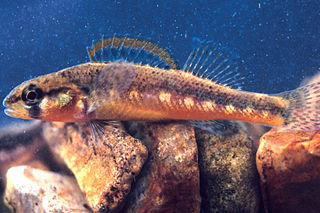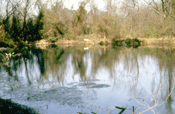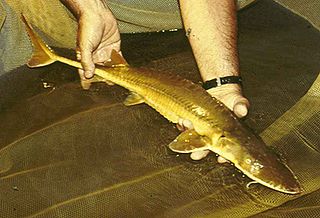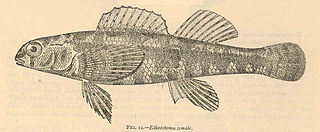
The snail darter is a small species of freshwater ray-finned fish, a darter from the subfamily Etheostomatinae, part of the family Percidae, which also contains the perches, ruffes and pikeperches. It is found in East Tennessee freshwater in the United States and in small portions of northern Alabama and Georgia. First recorded in 1973, the snail darter was listed as endangered under the U.S. Endangered Species Act of 1973 by 1975. The species was at the center of a major environmental law controversy that involved a lawsuit seeking to halt the completion of Tellico Dam, which posed a risk of extinction for the snail darter by blocking its migratory route. The case was eventually appealed to the U.S. Supreme Court, which ruled on it in its 1978 decision Tennessee Valley Authority v. Hill.
The Wheeler National Wildlife Refuge is a 35,000-acre (142 km2) national wildlife refuge (NWR) located along the Tennessee River near Decatur, Alabama. Named after Major General Joseph Wheeler, it was established to provide a habitat for wintering and migrating birds in the Eastern United States.

The fountain darter is a species of freshwater ray-finned fish, a darter from the subfamily Etheostomatinae, part of the family Percidae, which also contains the perches, ruffes and pikeperches. It is found in the headwaters of only two rivers in Texas, United States: the Comal River and the San Marcos River. It is generally smaller than 3 cm (1.2 in) long and feeds on small invertebrates. It is a federally listed endangered species of the United States and is also listed as endangered by the IUCN.

The slackwater darter is a small species of the freshwater ray-finned fish and a darter from the subfamily Etheostomatinae, part of the family Percidae, which also contains the perches, ruffes and pikeperches. Some authors consider it to be a member of the stippled darter group. The slackwater darter has a conspicuous dark subocular bar and three prominent saddles. It is rather drab in color, with the dorsum being dusky, olivaceous, or brownish. The lateral blotches are dark brown to blue-black. The venter is slightly dusky and may have some orange and yellow pigments, which are more intense in males than in females. Maximum size is about 55 millimetres (2.2 in) standard length.

Watercress Darter National Wildlife Refuge is a 25-acre (100,000 m2) National Wildlife Refuge located in Jefferson County, Alabama, within the city limits of Bessemer. Watercress Darter NWR consists of a .25-acre (1,000 m2) pond known as Thomas Spring which is essential to the survival of the endangered watercress darter. A second pond was built on the site in 1983. The facility is unstaffed, but is administered by the Mountain Longleaf National Wildlife Refuge in Anniston, Alabama.

The Alabama sturgeon is a species of sturgeon native to the United States of America and now only believed to exist in 130 miles (210 km) of the lower Alabama River. The fish has a distinctive yellowish-orange color, grows to a size of about 30 in (76 cm) long and 2 to 3 lb (0.9–1.4 kg), and is believed to have a lifespan of 12 to 20 years. Biologists have known of the fish since the 1950s or 1960s, but the large diversity of aquatic species in Alabama prevented formal identification until 1991.
The ashy darter is a species of freshwater ray-finned fish, a darter from the subfamily Etheostomatinae, part of the family Percidae, which also contains the perches, ruffes and pikeperches. It is endemic to the eastern United States.
The redband darter is a species of freshwater ray-finned fish, a darter from the subfamily Etheostomatinae, part of the family Percidae, which also contains the perches, ruffes and pikeperches. It is endemic to the state of Tennessee in the eastern United States.
The Bayou darter is a rare species of freshwater ray-finned fish, a darter from the subfamily Etheostomatinae, part of the family Percidae, which also contains the perches, ruffes and pikeperches. It is endemic to western Mississippi in the United States, where it is found only in Bayou Pierre and its tributaries. Its typical habitat is fast-flowing creeks and streams, in riffles and in areas between riffles with firm gravel bottoms. It feeds on small insects and their larvae. Breeding probably takes place twice a year, in spring and late summer. The population of this fish is declining due to loss of suitable habitat. This is caused by siltation and pollution, particularly erosion caused by changes in land use. The International Union for Conservation of Nature has assessed its conservation status as being "endangered".

The trispot darter is a species of freshwater ray-finned fish, a darter from the subfamily Etheostomatinae, part of the family Percidae, which also contains the perches, ruffes and pikeperches. It is endemic to northern Georgia and southern Tennessee in the United States, where it occurs in the Conasauga River and its tributaries and historically in the Alabama River system. It requires two interconnecting habitats; outside the breeding season it occupies the peripheral zones of the main river, with slow-moving water and silt gravel substrates with vegetation cover; during the breeding season it moves to warmer water with a clay-bottomed substrate with much vegetation. The population of this fish is declining due to loss of suitable habitat because of stream impoundment and land development. The International Union for Conservation of Nature has assessed its conservation status as being "vulnerable".

The boulder darter is a species of freshwater ray-finned fish, a darter from the subfamily Etheostomatinae, part of the family Percidae, which also contains the perches, ruffes and pikeperches. It is endemic to Alabama and Tennessee in the United States, where it occurs in the Elk River system and Shoal Creek. It is found in small rivers and fast-flowing streams, at least 2 ft (0.6 m) deep, with boulders or a rocky base. It feeds on aquatic insect larvae but little is known of its natural history. The population trend of this fish is unknown but it is affected by a rise in siltation and the impoundment of water within its range by the building of dams. The International Union for Conservation of Nature has assessed its conservation status as being "vulnerable".
The harlequin darter is a species of ray-finned fish, a darter from the subfamily Etheostomatinae, part of the family Percidae which includes the perches, ruffes and pike-perches. It is endemic to the eastern half of the United States.

The vermilion darter is a species of freshwater ray-finned fish, a darter from the subfamily Etheostomatinae, part of the family Percidae, which also contains the perches, ruffes and pikeperches. It is endemic to the southern United States, where it only is found in Turkey Creek in Jefferson County, Alabama, part of the Mobile Bay drainage basin. It was first described by Herbert Boschung in 1992, who was the curator of ichthyology at the University of Alabama, along with biologist Richard Mayden and scientific illustrator Joseph Tomelleri. On December 7, 2010, the US Fish and Wildlife Service designated 13 mi (21 km) of Turkey Creek watershed as critical habitat for the darter. According to the IUCN, the population of this fish is declining.
The lollipop darter is a species of freshwater ray-finned fish, a darter from the subfamily Etheostomatinae, part of the family Percidae, which also contains the perches, ruffes and pikeperches. It is endemic to the eastern United States. Lollipop darters are approximately 1.4 to 2.4 inches long.
The goldstripe darter is a species of freshwater ray-finned fish, a darter from the subfamily Etheostomatinae, part of the family Percidae, which also contains the perches, ruffes and pikeperches. It is endemic to the southeastern United States where it is found in Gulf Slope streams from the Colorado River drainage in Texas to the Flint River in Georgia, the Atlantic Slope in Ocmulgee River system, Georgia, and the Mississippi embayment north as far as southeastern Missouri and western Kentucky. It is typically found in small springs, streams, and creeks with aquatic and marginal vegetation and detritus. The female spawns on multiple occasions between about mid-March and June, sticking the adhesive eggs to plants, gravel and the sides of rocks. The goldstripe darter is a common species with a wide range and numerous sub-populations, and the International Union for Conservation of Nature has assessed its conservation status as being of "least concern".

Etheostoma rufilineatum, the redline darter, is a species of freshwater ray-finned fish, a darter from the subfamily Etheostomatinae, part of the family Percidae, which also contains the perches, ruffes and pikeperches. It is endemic to the southeastern United States.
The Citico darter is a threatened species of freshwater ray-finned fish, a darter from the subfamily Etheostomatinae, part of the family Percidae, which also contains the perches, ruffes and pikeperches. It is native to Tennessee. This species was formerly subsumed within Etheostoma percnurum. The E. percnurum group now consists of four distinct species: E. percnurum, E. marmorpinnum, E. lemniscatum, and E. sitikuense.

Etheostoma zonale, the banded darter, is a species of freshwater ray-finned fish, a darter from the subfamily Etheostomatinae, part of the family Percidae, which also contains the perches, ruffes and pikeperches. It is endemic to the eastern United States. It is mainly found in the Mississippi Basin, ranging from the Verdigris River in Kansas eastward to the Allegheny River in New York, and from the Minnesota River in Minnesota southward to the Ouachita River in Arkansas and the Tennessee River in Alabama. Its typical habitat in small and medium-sized rivers is riffles over cobble or gravel, rock slabs, and small boulders. It feeds on the riverbed on small insect larvae and is itself eaten by birds and larger fish. Males become more colorful and become territorial before spawning which takes place in spring. The females attach the eggs to waterweed. The population trend of this fish seems to be stable, it is a common species with numerous sub-populations over a wide range, no major threats have been identified and the International Union for Conservation of Nature has assessed its conservation status as being of "least concern".

The relict darter is a rare species of freshwater ray-finned fish, a darter from the subfamily Etheostomatinae, part of the family Percidae, which also contains the perches, ruffes and pikeperches. It is endemic to Kentucky, where it occurs only in the drainage of the Bayou de Chien. It is a federally listed endangered species of the United States.

The rush darter is a rare and endangered species of freshwater ray-finned fish, a darter from the subfamily Etheostomatinae, part of the family Percidae, which also contains the perches, ruffes and pikeperches. It is endemic to Alabama in the United States, where it occurs in three river systems. It was federally listed as an endangered species of the United States on August 9, 2011.













